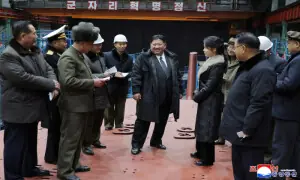China tightens security after rare protests against COVID curbs
SHANGHAI/BEIJING: Police on Monday stopped and searched people at the sites of weekend protests in Shanghai and Beijing, after crowds there and in other Chinese cities demonstrated against stringent COVID-19 measures disrupting lives three years into the pandemic.
From the streets of several Chinese cities to dozens of university campuses, protesters made a show of civil disobedience unprecedented since leader Xi Jinping assumed power a decade ago. During his tenure, Xi has overseen the quashing of dissent and expansion of a high-tech social surveillance system that has made protest more difficult, and riskier.
“What we object to is these restrictions on people’s rights in the name of virus prevention, and the restrictions on individual freedom and people’s livelihoods,” said Jason Sun, a college student in Shanghai.
There was no sign of new protests on Monday in Beijing or Shanghai, but dozens of police were in the areas where the demonstrations took place.
Police have been asking people for their phones to check if they had virtual private networks (VPNs) and the Telegram app, which has been used by weekend protesters, residents and social media users said. VPNs are illegal for most people in China, while the Telegram app is blocked from China’s internet.
Asked about widespread anger over China’s zero-COVID policy, foreign ministry spokesman Zhao Lijian told reporters: “What you mentioned does not reflect what actually happened.
“We believe that with the leadership of the Communist Party of China, and cooperation and support of the Chinese people, our fight against COVID-19 will be successful.”
Backlash
The backlash against COVID curbs is a setback for China’s efforts to eradicate the virus, which is infecting record numbers after swathes of the population have sacrificed income, mobility and mental health to prevent it from spreading.
The zero-COVID policy has kept China’s official death toll in the thousands, against more than a million in the United States, but has come at the cost of confining many millions to long spells at home, bringing extensive disruption and damage to the world’s second-largest economy.
Abandoning it would mean rolling back a policy championed by Xi. It would also risk overwhelming hospitals and lead to widespread illness and deaths in a country with hundreds of millions of elderly and low levels of immunity to COVID, experts say.
The protests roiled global markets on Monday, sending oil prices lower and hammering Chinese stocks (.CSI300) and the yuan .
State media did not mention the protests, instead urging citizens in editorials to stick to COVID rules. Many analysts say China is unlikely to re-open before March or April, and needs an effective vaccination campaign before that.
“The demonstrations do not imminently threaten the existing political order, but they do mean the current COVID policy mix is no longer politically sustainable,” analysts at Gavekal Dragonomics wrote in a note.
“The question now is what re-opening will look like. The answer is: slow, incremental and messy.”
Blue barriers
Late on Sunday, protesters clashed with police in the commercial hub of Shanghai, where its 25 million people were stuck at home in April and May, with security forces taking away a busload of people.
On Monday, authorities blocked some central Shanghai streets with blue metal barriers to prevent gatherings. Shops and cafes in the area were asked to close, a staff member at one told Reuters.
China’s COVID policy is a major source of uncertainty for investors. The protests around it are being watched for any sign of political instability, something many of them had not considered in authoritarian China, where Xi recently secured a third leadership term.
Martin Petch, vice president at Moody’s Investors Service, said the ratings agency expected the protests “to dissipate relatively quickly and without resulting in serious political violence”.
“However, they have the potential to be credit negative if they are sustained and produce a more forceful response by the authorities.”
Urumqi fire
The catalyst for the protests was an apartment fire last week in the western city of Urumqi that killed 10 people. Many speculated that COVID curbs in the city, parts of which had been under lockdown for 100 days, had hindered rescue and escape, which city officials denied.
Crowds in Urumqi took to the street on Friday. Over the weekend, protesters in cities including Wuhan and Lanzhou overturned COVID testing facilities, while students gathered on campuses across China.
Demonstrations have also been held in at least a dozen cities around the world in solidarity. read more
Discussion of the protests, as well as pictures and footage, sparked a game of cat-and-mouse between social media users and censors.
In Beijing, large crowds of peaceful people gathered past midnight on Sunday on a city ring road, some holding blank pieces of paper in a symbol of protest.
On Sunday in Shanghai, some protesters briefly chanted anti-Xi slogans, almost unheard of in a country where Xi has a level of power unseen since Mao Zedong’s era.
While anger with the COVID rules simmers, some expressed opposition to people taking to the streets.
“These actions will disturb the public order,” resident Adam Yan, 26, said. “It’s best to believe in the government.”
For the latest news, follow us on Twitter @Aaj_Urdu. We are also on Facebook, Instagram and YouTube.




















Comments are closed on this story.